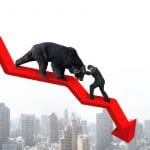We have recently witnessed an unprecedented period of volatility across the financial markets with many being “Limit Down” on a regular basis.
Those of us with a few grey hairs on our head (should that now be a few too many?) have seen market corrections before. But the speed with which markets moved to downside over recent weeks has taken old stagers and those new to the markets by storm. One month ago (19-02-20) the S&P 500 printed new intraday highs at 3393.52. The index closed last night (19-03-20) at 2409.39, down by just under 1000 points or -29.0%, in a matter of weeks. Equity markets across the globe have moved into bear market territory during the last month.
The table below shows the performance and current trend, for a range of leading equity indices across the Americas, Europe and Asia Pacific regions. The YTD or Year to Date percentage change shows just how sharp the selloff has been.
|
Name |
Trend |
Close |
1 Day change |
1 Week change |
YTD change |
|
DJ Industrials |
Bear |
20087.2 |
0.90% |
-5.30% |
-29.60% |
|
S&P 500 Index |
Bear |
2409.39 |
0.50% |
-2.90% |
-25.40% |
|
NASDAQ 100 |
Bear |
7288.52 |
1.60% |
0.30% |
-16.50% |
|
NASDAQ Comp. |
Bear |
7150.58 |
2.30% |
-0.70% |
-20.30% |
|
FTSE 100 |
Bear |
5151.61 |
1.40% |
-1.60% |
-31.70% |
|
Euro Stoxx 50 |
Bear |
2454.08 |
2.90% |
-3.60% |
-34.50% |
|
Germany DAX Index |
Bear |
8610.43 |
2.00% |
-6.00% |
-35.00% |
|
France CAC40 Index |
Bear |
3855.5 |
2.70% |
-4.70% |
-35.50% |
|
Italy FTSE MIB Index |
Bear |
15467 |
2.30% |
3.80% |
-34.20% |
|
Spain IBEX 35 Index |
Bear |
6395.8 |
1.90% |
0.10% |
-33.00% |
|
Sweden OMX Index |
Bull |
1415.99 |
2.60% |
2.90% |
-20.10% |
|
Switzerland SMI Index |
Bull |
8782.24 |
5.30% |
6.20% |
-17.30% |
|
Japan Nikkei 225 Index |
Bear |
16552.8 |
-1.00% |
-10.80% |
-30.00% |
|
HK Hang Seng Index |
Bear |
21709.1 |
-2.60% |
-10.70% |
-23.00% |
|
Shanghai Composite Index |
Bear |
2702.13 |
-1.00% |
-7.60% |
-11.40% |
|
India BSE Sensex Index |
Bear |
28288.2 |
-2.00% |
-13.70% |
-31.50% |
|
Australia ASX200 Index |
Bear |
4782.94 |
-3.40% |
-9.80% |
-28.40% |
|
Brazil Bovespa Index |
Bear |
68331.8 |
2.10% |
-5.90% |
-40.90% |
|
Canada TSX Composite |
Bear |
12170.5 |
3.80% |
-2.70% |
-28.70% |
|
CBOE Volatility Index (VIX) |
Bull |
72 |
-5.80% |
-4.60% |
422.50% |
Source: Investors Intelligence eod 19-03-20
Prior to this landslide we were of course in the midst of an 11-year bull market, which was itself one of the longest uptrends in history.
We have had a perfect storm in the markets thanks to a combination of an oil price war and the rapid spread of the Covid-19 coronavirus. Neither of these items was the “cause” of the market selloff but they were undoubtedly the catalysts and when mixed with an over leveraged ,over extended, and dare one say bubble like market there was only ever going to be one reaction possible – which was the market boiling over.
Could it have been worse?
Horrifying as recent market moves have been, we have to ask the question could it have been worse? The answer to that is probably yes it could have been. So, what actions have prevented an even greater calamity?
Well, the prompt moves by central banks who have slashed interest rates, pumped liquidity (cash) into the markets and (re) introduced large scale QE programs, have brought a semblance of stability back into the markets. Though it’s unclear if that (relative stability) is going to be a permanent fixture from here on in. Somehow, I doubt that it is.
Actions at the coalface of trading have also played their part. however, with so called circuit breakers coming into play over recent weeks. If you have been following events in the market through the media, you will probably have heard or read the phrases limit down, limit up and circuit breaker in their commentary.
But what do these terms actually mean?
Markets, and the moves within them are driven by sentiment and crowd behaviour. This has always been the case whether we traded face to face on a trading floor or exchange, or across the internet.
In fact, it could be argued that electronic screen-based trading has amplified the importance of market sentiment and has increased the size and connectivity of the trading crowd.
Trader sentiment is influenced by the flow of new information, that new information takes many forms, but a trading screen filled with prices moving quickly in one direction conveys lots of visual information, that can be absorbed very quickly by traders who are looking at them.
Changes in sentiment
There is an old saying in trading “that themarkets take the stairs up and the lift down”. What that literally means is that in the markets, fear outweighs greed.
Investor greed translates into bullish sentiment that builds, over time to a crescendo, (though everyone seems to forget about the inevitable peak at the time). Fear among investors and traders acts and spreads much more quickly and that leads to analogies of markets and prices “falling off of a cliff”
A trading screen filled with flashing red (falling) prices, both spreads and reinforces the fear of loss among traders. Today of course, we can take our price feed with us, everywhere we go. Thus, a self-reinforcing feedback loop of fear is not that difficult to create, particularly in an age where so much CFD trading is driven by algorithms not just humans.
Restoring order
To maintain orderly markets and to prevent feedback loops (on both the up and downside in the markets), from gaining control, exchanges have introduced a series of maximum price moves that can occur in an instrument, and groups of instruments, before a trading halt is called.
The idea is to create some breathing space for the market, a chance for traders to cool off before trading recommences.
For example, the NYSE has market wide circuit breakers (MWCB) that kick in if the S&P 500 index falls by -7.0% from the prior trading days close. If triggered, trading across the NYSE is halted for a period of 15 minutes. There are subsequent circuit breakers for moves of -13%, and indeed, -20% from the prior days close.
Tracking price moves
Controls on the price range of individual stocks and instruments will vary by asset type and quality, as well as exchange for example on the London Stock Exchange if the price of a security traded on the orderbook moves by +/-10%, to the upside or downside, we have a trading halt and traders have the opportunity to submit orders for an auction that restarts the trading process after a ten minute break.
When an instrument has triggered one of these price move restrictions and trading is halted, they are said to be limit-up, in the case of an instrument whose price has risen sharply, or limit-down in the case of an instrument whose price has fallen sharply.
A new equilibrium
When prices move, they are trying to find a new equilibrium level, that is a price point that matches supply with demand, and at which business can take place.
Sharp deviations in price occur when the balance between these two forces moves out of kilter. The ensuing trading halt or pause allows market participants to reassess the situation and to identify price levels on the upside or downside, where business can be conducted when trading resumes.
A move to a limit-up or limit-down situation does not remove excess buying or selling pressure of course, and the imbalance between supply and demand may re-appear immediately as trading recommences. The idea however is for the trading halt to act like a release valve on a pressure cooker and stop the lid literally being blown off.

Richard is the founder of the Good Money Guide (formerly Good Broker Guide), one of the original investment comparison sites established in 2015. With a career spanning two decades as a broker, he brings extensive expertise and knowledge to the financial landscape.
Having worked as a broker at Investors Intelligence and a multi-asset derivatives broker at MF Global (Man Financial), Richard has acquired substantial experience in the industry. His career began as a private client stockbroker at Walker Crips and Phillip Securities (now King and Shaxson), following internships on the NYMEX oil trading floor in New York and London IPE in 2001 and 2000.
Richard’s contributions and expertise have been recognized by respected publications such as BusinessInsider, Yahoo Finance, BusinessNews.org.uk, Master Investor, Wealth Briefing, iNews, and The FT, among many others.
Under Richard’s leadership, the Good Money Guide has evolved into a valuable destination for comprehensive information and expert guidance, specialising in trading, investment, and currency exchange. His commitment to delivering high-quality insights has solidified the Good Money Guide’s standing as a well-respected resource for both customers and industry colleagues.


